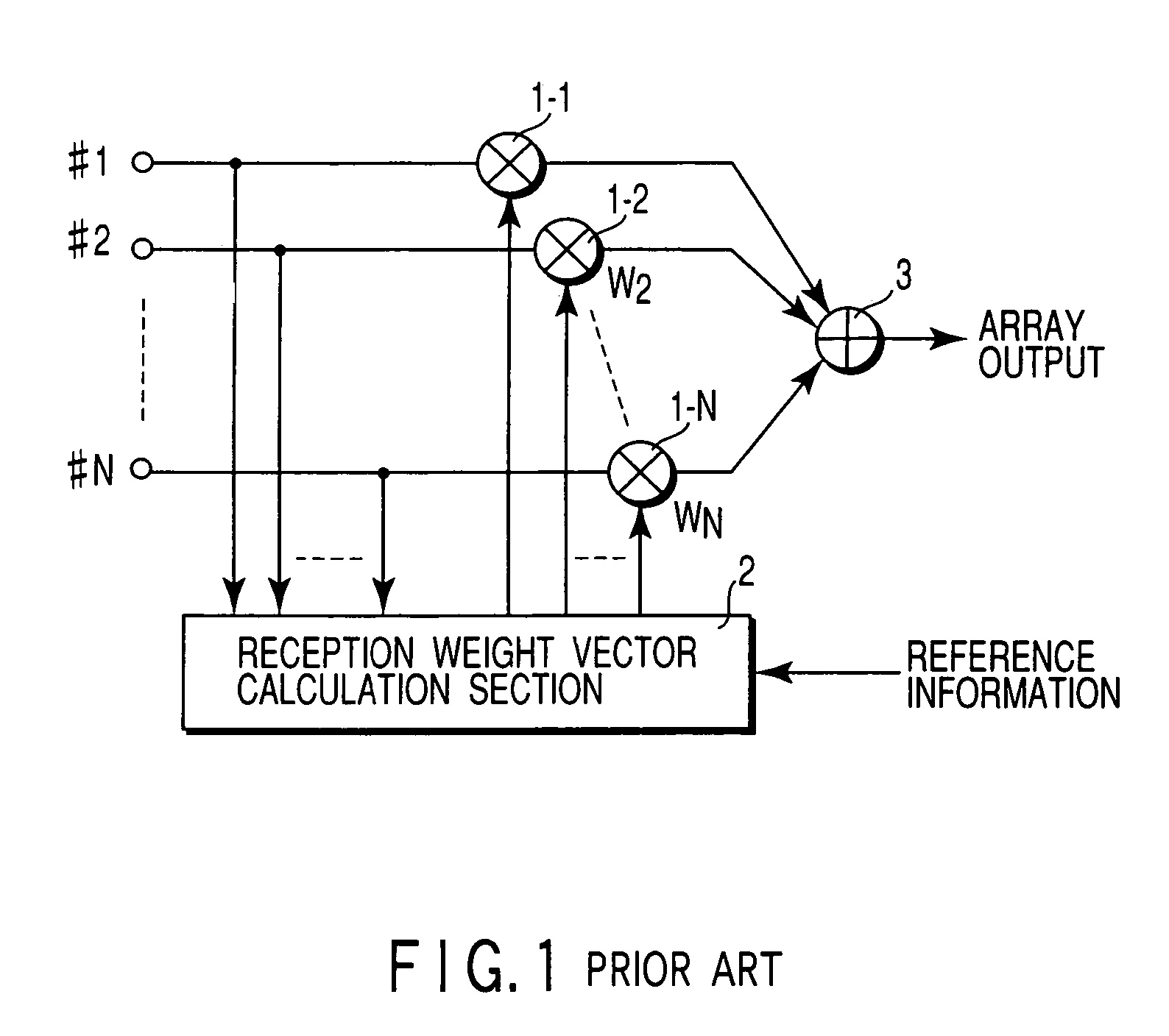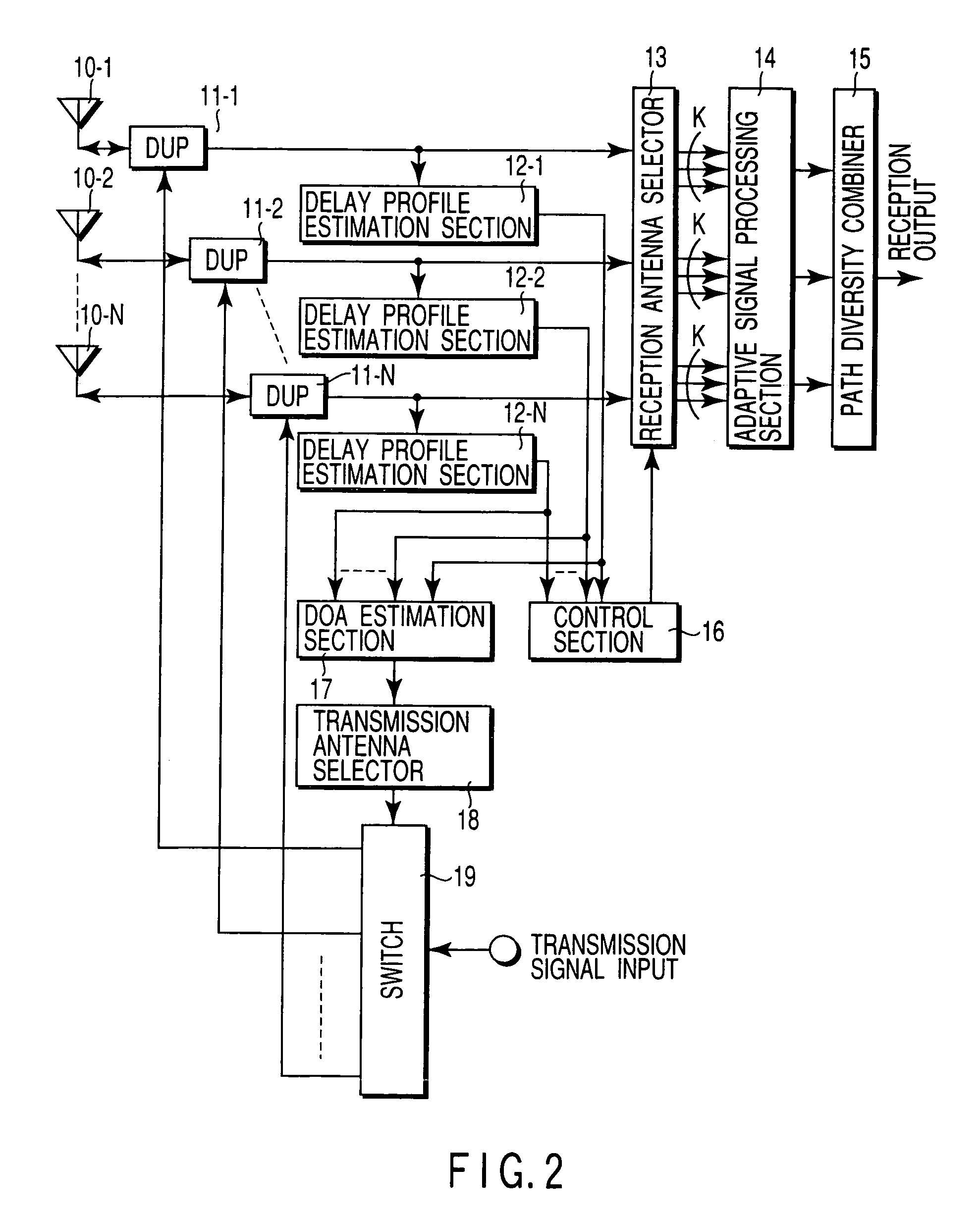Radio communication apparatus using adaptive antenna
- Summary
- Abstract
- Description
- Claims
- Application Information
AI Technical Summary
Benefits of technology
Problems solved by technology
Method used
Image
Examples
first embodiment
(First Embodiment)
[0049]FIG. 2 is a block diagram showing the structure of a radio communication apparatus according to a first embodiment of the present invention.
[0050]The radio communication apparatus of this embodiment comprises a plurality of antennas 10-1 to 10-N for transmission / reception, which have mutually different directivities; duplexers 11-11 to 11-N for dividing transmission / reception signals having different frequencies; delay profile estimation sections 12-1 to 12-N; a reception antenna selector 13 for selecting a predetermined number of antennas for reception (i.e. reception antennas) from the antennas 10-1 to 10-N; an adaptive signal processing section 14 and a path diversity combiner 15 for subjecting the received signals from the selected reception antennas to a temporal / spatial equalization signal processing; a control section 16 for controlling the reception antenna selector 13; a DOA (Direction of Arrival) estimation section (an arrival angle range estimation...
second embodiment
(Second Embodiment)
[0068]FIG. 4 shows the structure of a radio communication apparatus according to a second embodiment of the invention. The structural elements common to those in FIG. 2 are denoted by like reference numerals, and only differences from the first embodiment will be described.
[0069]In the second embodiment, omni-directional antennas 20-1 to 20-N are substituted for the directional antennas 10-1 to 10-N used in the first embodiment. A beam forming section 21 is connected between the antennas 20-1 to 20-N and the duplexers 11-1 to 11-N. The beam forming section 21 forms a plurality of beams with different directions of radiation (i.e. different directivities), that is, a plurality of directivity patterns. The beam forming section 21 may be realized, for example, by a Butler matrix circuit using analog elements, or a digital circuit performing spatial FFT (Fast Fourier Transform).
[0070]Since the beam forming section 21 is used, the reception antenna selector 13 in FIG. ...
third embodiment
(Third Embodiment)
[0075]FIG. 5 shows the structure of a radio communication apparatus according to a third embodiment of the invention. This embodiment is based on the structure of the first embodiment, and it aims at forming a transmission beam pattern capable of effectively enhancing an average reception SIR at an opposing-side station, or a terminal station.
[0076]The structural elements common to those in FIG. 2 are denoted by like reference numerals, and only differences from the first embodiment will be described. In the third embodiment, a direction of arrival estimation section 27 for estimating a direction of arrival of a desired wave is provided in addition to the arrival angle range estimation section 17 for estimating an arrival angle range of a desired wave in the first and second embodiments. In addition, a transmission weight vector generator 30 is added, and the switch 19 in FIG. 2 is replaced with weighting sections (multipliers) 31-1 to 31-N.
[Re: Reception Operation...
PUM
 Login to View More
Login to View More Abstract
Description
Claims
Application Information
 Login to View More
Login to View More - R&D
- Intellectual Property
- Life Sciences
- Materials
- Tech Scout
- Unparalleled Data Quality
- Higher Quality Content
- 60% Fewer Hallucinations
Browse by: Latest US Patents, China's latest patents, Technical Efficacy Thesaurus, Application Domain, Technology Topic, Popular Technical Reports.
© 2025 PatSnap. All rights reserved.Legal|Privacy policy|Modern Slavery Act Transparency Statement|Sitemap|About US| Contact US: help@patsnap.com



